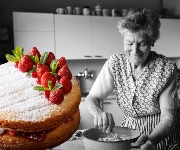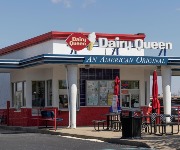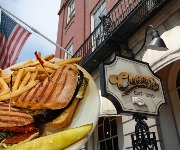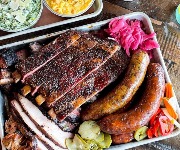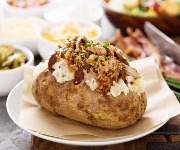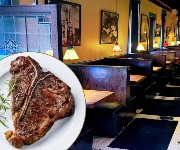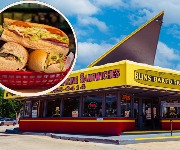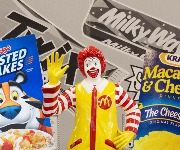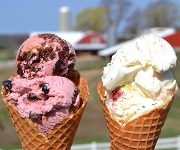Captain Birds Eye to Uncle Ben: The top 5 fictional food icons
Captain Birds Eye, Uncle Ben or maybe Aunt Bessie - who's your favourite fictional food icon? Here's our top five...
Captain Birds Eye
Captain Birds Eye has been loved by children since the 1960s, but his life as the face of fish fingers has been as choppy as the high seas he sails. The original Captain Birds Eye first appeared in a 1967 TV commercial, as a bearded, genial sea cap’n, played by actor John Hewer. Birds Eye got rid of the character in 1971, prompting The Times to run an obituary. The brand resurrected the Cap’n in 1974 and from there it was plain sailing until the 90s, when Hewer was replaced by a rugged young actor called Thomas Pescod. A public backlash ensued, which doesn’t surprise branding expert Stuart Brown of Brown Communications. ‘Consumers have grown up with characters like Captain Birds Eye, so have an emotional attachment to them. Captain Birds Eye was a friendly man, similar to many granddads, which helped crystallise that connection.’
The Captain soon returned, played by actor Martin Reid. But this triumph for Captain Birds Eye fans was short lived – in 2010; he was replaced by Clarence the polar bear.
Uncle Ben
Uncle Ben is inspired by two real-life men, an African-American rice farmer called Ben (his surname remains a mystery) and Frank Brown, the Maitre D’ at a Chicago hotel frequented by execs from Converted Rice Inc in the 1940s. The company modelled Uncle Ben, complete with his white hair, waiter’s bow-tie and blue blazer, on a portrait of Frank. He made his first advertising appearance in 1946.
Converted Rice Inc sold the brand to Mars and in 2007, Mars US gave Ben a ‘promotion’ to chairman of the board. Adverts and the brand’s website depicted Ben in a boardroom, his blue waiter’s jacket now a business suit. A wise move, considering the whiff of controversy that surrounds American food brands such as Aunt Jemima that invoke outmoded racial stereotypes? Yes, thinks Stuart Brown. ‘This was one way to appease those who felt an emotional attachment to the character whilst retaining the values the brand has built over the years.’
Mr Kipling
Little is known about the mysterious Mr Kipling aside from, of course, the fact he makes ‘exceedingly good cakes’. The brand launched in the late 60s. The classic Mr Kipling ads of the 70s and 80s were narrated by actor James Hayter, playing Kipling’s nameless confidante. Watch some of those old ads again, and clues emerge about Kipling. A 1978 advert for fondant fancies reveals he has a nephew called Richard and likes model trains, while another ad for apple pies indicates he lives in a village and paints watercolours. But this retirement came after a glittering career – in a 1978 advert for Bakewell Tart, Kipling reveals he once ‘catered a Maharajah’s banquet.’ Experts disagree on whether the faceless Kipling is an effective adverting tool. Crispin Reed, MD of branding agency Brandhouse thinks Kipling is ‘exceedingly clever,’ precisely because we know so little about him. ‘He isn't a tangible character but the figment of our imagination created by a crusty voiceover and farmhouse set.’ Stuart Brown disagrees: ‘Those old TV ads are actually rather creepy. The voice, the fact you never saw him, some consumers would now interpret that character as a bit sinister.’
Betty Crocker
In the US, Betty Crocker is better known than Delia, Nigella and Julia Child combined. The difference? This famous baker and food writer is fictional. ‘Betty Crocker’ was invented by the Washburn Crosby Company in 1921 as a food agony aunt, to answer the 1000s of baking questions the company received from consumers. The name Betty was chosen as it was ‘friendly sounding’ according to Betty Crocker’s now parent company General Mills, and Crocker was the surname of a retired company director. For many years, home economist Majorie Husted was the real-life woman behind the fictional Betty, scripting and voicing Betty’s own radio show from 1924, ‘the Betty Crocker cookery school of the air.’ Being imaginary didn’t stop Betty from going on to star in her own TV show and adverts in the 1950s (she was played by actress Adelaide Hawley), publishing dozens of best-selling cookbooks or launching her famous range of cake mixes.
Aunt Bessie
Aunt Bessie was created by the brand’s then marketing director in 1994. The famous frozen Yorkshire puddings themselves predate Bessie by 20 years – the brand started life selling its products to Butlins in 1974.
Although the image of Aunt Bessie on the brand’s logo is of a smiling woman with a matronly bun wearing a blue dress and pinny, a spokesperson for the brand says Aunt Bessie ‘doesn’t have a particular age and has no specific characteristics. Instead, Bessie is ‘an “iconic” representation of aunts around the UK,’ and ‘a set of values that provide a feeling of warmth and comfort from family and nostalgia’. Crispin Reed believes Bessie’s traditional values are still relevant to modern female consumers as ‘they may seem to represent a bygone era and be anachronistic, but underneath they represent stability and nurturing.’
Enjoyed this? Then you might like...
Food ads from yesteryear – A woman’s place
Most Recent
Comments
Be the first to comment
Do you want to comment on this article? You need to be signed in for this feature
